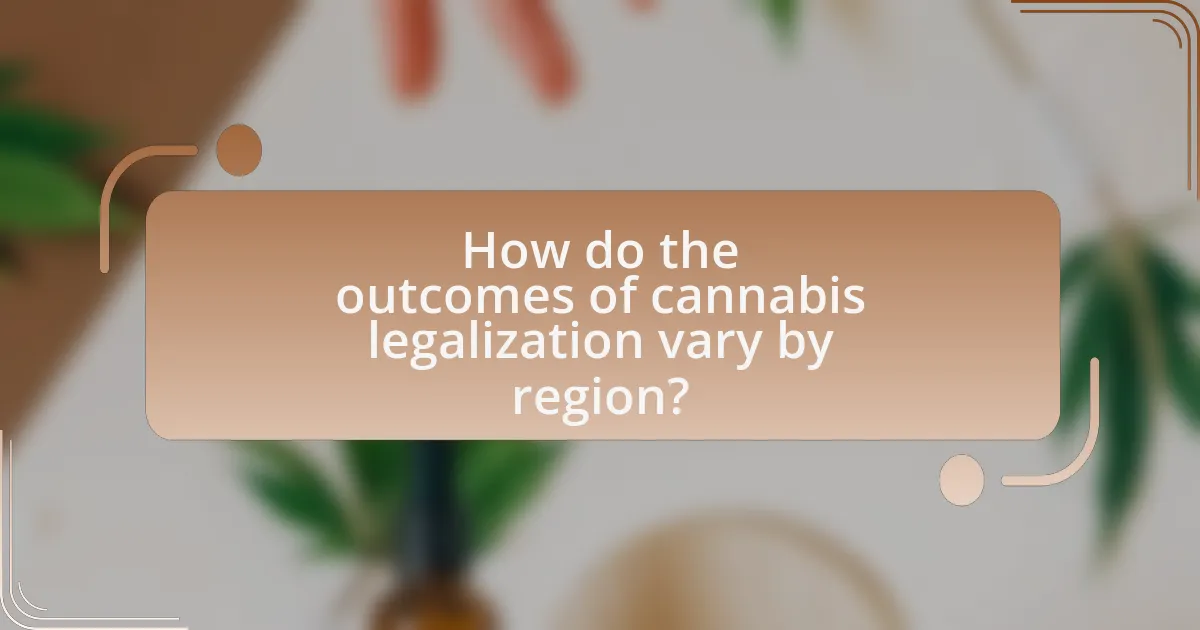The article focuses on the key lessons learned from international cannabis legalization efforts, highlighting the importance of regulatory frameworks, public health considerations, and economic impacts. It examines various approaches to legalization adopted by different countries, such as full legalization in Canada and decriminalization in the Netherlands, and discusses the influence of cultural attitudes on these strategies. The article also addresses challenges faced during the legalization process, including regulatory inconsistencies and public health concerns, while showcasing the successes observed in regions that have legalized cannabis, such as increased tax revenue and reduced crime rates. Additionally, it emphasizes the role of international cooperation and treaties in shaping national policies and outlines best practices for future legalization efforts.

What are the key lessons learned from international cannabis legalization efforts?
Key lessons learned from international cannabis legalization efforts include the importance of regulatory frameworks, public health considerations, and economic impacts. Countries that implemented comprehensive regulatory systems, such as Canada, have shown that clear guidelines can reduce illegal market activity and enhance consumer safety. For instance, Canada’s legalization in 2018 led to a significant decrease in black market sales, with legal sales reaching CAD 4.6 billion in 2020. Additionally, public health initiatives, including education and prevention programs, are crucial in addressing potential health risks associated with cannabis use. Economic benefits have also been evident, as seen in the U.S. states that legalized cannabis, which generated over $17 billion in tax revenue in 2020, demonstrating the financial viability of legalization. These examples underscore the necessity of a balanced approach that considers regulatory, health, and economic factors in successful cannabis legalization.
How have different countries approached cannabis legalization?
Different countries have approached cannabis legalization through various models, including full legalization, decriminalization, and medical use frameworks. For instance, Canada fully legalized cannabis for recreational use in 2018, establishing a regulated market that includes age restrictions and taxation, which has generated significant tax revenue and reduced illegal sales. In contrast, the Netherlands has a long-standing policy of tolerance towards cannabis use, allowing regulated sales in “coffeeshops,” but it remains technically illegal, illustrating a decriminalization approach. Uruguay became the first country to fully legalize cannabis in 2013, implementing a state-controlled system that allows citizens to grow their own cannabis or purchase it from pharmacies, aiming to combat drug trafficking. Meanwhile, many U.S. states have legalized cannabis for recreational use, despite federal prohibition, creating a patchwork of laws that vary significantly across the country. These diverse approaches highlight the complexities and varying societal attitudes towards cannabis, influencing public health, law enforcement, and economic outcomes.
What models of legalization have been implemented globally?
Various models of cannabis legalization have been implemented globally, including full legalization, decriminalization, and medical use frameworks. Full legalization, as seen in countries like Canada and Uruguay, allows for the legal production, sale, and consumption of cannabis for both recreational and medicinal purposes. Decriminalization, practiced in places like Portugal, removes criminal penalties for possession and personal use but does not establish a legal market. Medical use frameworks, such as those in Germany and Australia, permit cannabis use for specific medical conditions under regulated circumstances. These models reflect diverse approaches to cannabis policy, influenced by cultural, social, and political factors.
How do cultural attitudes influence legalization strategies?
Cultural attitudes significantly influence legalization strategies by shaping public opinion, political will, and policy frameworks. For instance, in countries where cannabis is viewed positively, such as Canada, legalization efforts have gained strong support, leading to comprehensive regulatory frameworks that prioritize public health and safety. Conversely, in nations with negative cultural perceptions of cannabis, such as many parts of the United States prior to 2012, legalization faced substantial opposition, resulting in fragmented and cautious approaches. Research indicates that societal acceptance correlates with the speed and extent of legalization; for example, a 2019 study published in the Journal of Drug Policy Analysis found that public support for cannabis legalization increased from 25% in 1990 to over 60% by 2018 in the U.S., directly impacting state-level legalization initiatives. Thus, cultural attitudes serve as a critical determinant in the formulation and success of cannabis legalization strategies.
What challenges have countries faced during the legalization process?
Countries have faced significant challenges during the legalization process of cannabis, including regulatory inconsistencies, public health concerns, and economic implications. Regulatory inconsistencies arise when different regions within a country adopt varying laws, leading to confusion and enforcement difficulties. Public health concerns often focus on the potential increase in substance abuse and the need for effective education and prevention programs. Economic implications include the complexities of taxation and the impact on existing illegal markets, which can undermine the financial benefits of legalization. For instance, in Canada, the legalization of cannabis in 2018 highlighted these challenges, as provinces implemented diverse regulations that complicated compliance for businesses and consumers alike.
What legal hurdles have emerged in various jurisdictions?
Legal hurdles that have emerged in various jurisdictions regarding cannabis legalization include conflicting federal and state laws, regulatory inconsistencies, and challenges related to banking and taxation. For instance, in the United States, cannabis remains classified as a Schedule I substance under federal law, creating a legal conflict for states that have legalized its use. Additionally, jurisdictions like Canada face challenges with provincial regulations that differ from federal guidelines, leading to confusion in compliance. Furthermore, cannabis businesses often struggle with limited access to banking services due to federal restrictions, which complicates financial operations and tax obligations. These legal complexities hinder the effective implementation of cannabis legalization efforts across different regions.
How have public health concerns shaped legalization efforts?
Public health concerns have significantly influenced legalization efforts by highlighting the need for regulated access to cannabis to mitigate health risks associated with unregulated use. For instance, studies have shown that legalizing cannabis can lead to better control over product quality and safety, reducing the prevalence of contaminated or adulterated products that pose health risks. Additionally, public health campaigns have emphasized the potential benefits of legalization, such as reducing opioid prescriptions and associated overdose deaths, which have been documented in states like Colorado, where opioid-related fatalities decreased by 6.5% after legalization. These health-focused arguments have been pivotal in shaping public opinion and legislative decisions regarding cannabis legalization.
What successes have been observed in countries that legalized cannabis?
Countries that legalized cannabis have observed significant successes, including increased tax revenue, reduced law enforcement costs, and improved public health outcomes. For instance, in Colorado, cannabis legalization generated over $1.7 billion in tax revenue from 2014 to 2021, which has been allocated to education, healthcare, and infrastructure. Additionally, studies indicate that states with legalized cannabis have experienced a decrease in opioid-related deaths, suggesting a potential substitution effect. Furthermore, public safety has improved, with a reduction in cannabis-related arrests, allowing law enforcement to focus on more serious crimes. These outcomes demonstrate the positive impacts of cannabis legalization on both economic and social fronts.
How has legalization impacted crime rates and public safety?
Legalization of cannabis has generally led to a decrease in crime rates and an improvement in public safety. For instance, studies from states like Colorado and Washington, which legalized cannabis, indicate significant reductions in marijuana-related arrests and a decrease in violent crime rates. According to a report by the Colorado Department of Public Safety, the state experienced a 10% drop in overall crime rates in the years following legalization. Additionally, the legalization framework has allowed for better regulation and control of cannabis distribution, which has contributed to a safer environment by reducing the illegal market and associated criminal activities.
What economic benefits have arisen from cannabis legalization?
Cannabis legalization has generated significant economic benefits, including increased tax revenue, job creation, and reduced law enforcement costs. For instance, states like Colorado have reported over $1.7 billion in tax revenue since legalization in 2014, which has been allocated to education, healthcare, and infrastructure. Additionally, the cannabis industry has created thousands of jobs; in Colorado alone, the industry employed over 41,000 people by 2020. Furthermore, legalization has led to decreased expenditures on law enforcement and incarceration related to cannabis offenses, allowing governments to redirect funds to other public services. These economic impacts demonstrate the financial advantages associated with cannabis legalization.

How do the outcomes of cannabis legalization vary by region?
Outcomes of cannabis legalization vary significantly by region, influenced by factors such as regulatory frameworks, cultural attitudes, and economic conditions. For instance, in North America, particularly in states like Colorado and California, legalization has led to increased tax revenue, job creation, and a reduction in cannabis-related arrests. Conversely, in regions like Europe, where legalization is more limited, such as in Germany, outcomes include a focus on medical use rather than recreational, resulting in different economic impacts and public health approaches. Additionally, in countries like Uruguay, which was the first to fully legalize cannabis, the government-controlled model has aimed to reduce illegal market activity but has faced challenges in implementation and public acceptance. These regional differences highlight the importance of tailored approaches to cannabis policy, reflecting local contexts and objectives.
What differences exist between North American and European legalization efforts?
North American and European legalization efforts for cannabis differ primarily in their approaches and regulatory frameworks. In North America, particularly in Canada and several U.S. states, legalization has often been driven by a combination of public health, economic benefits, and social justice considerations, resulting in a more commercialized market. For instance, Canada legalized recreational cannabis nationwide in 2018, establishing a regulated market that includes production, distribution, and retail sales.
In contrast, European legalization efforts tend to be more cautious and varied, with many countries adopting a decriminalization approach rather than full legalization. For example, countries like the Netherlands have long allowed regulated cannabis sales in coffee shops, while others, such as Germany, are exploring pilot programs for regulated sales but have not yet implemented nationwide legalization. This reflects a more fragmented regulatory landscape in Europe, where cultural attitudes and legal frameworks differ significantly between countries.
Additionally, North American efforts often emphasize tax revenue generation and economic growth, while European discussions frequently focus on public health and harm reduction. This divergence illustrates the broader societal values influencing cannabis policy in each region.
How have regulatory frameworks differed in these regions?
Regulatory frameworks for cannabis legalization have varied significantly across regions, primarily in terms of legalization scope, regulatory bodies, and taxation structures. For instance, in Canada, the Cannabis Act of 2018 established a comprehensive federal framework that regulates production, distribution, and sale, while allowing provinces to set specific rules. In contrast, many U.S. states have adopted a patchwork approach, with states like California implementing their own regulations that differ widely from those in states like Texas, where cannabis remains largely illegal. Additionally, taxation on cannabis sales in Canada is federally mandated, whereas U.S. states have varying tax rates and structures, leading to disparities in revenue generation. These differences highlight the diverse approaches to cannabis regulation and the impact of local governance on legalization efforts.
What lessons can be drawn from the experiences of Canada and the Netherlands?
The experiences of Canada and the Netherlands highlight the importance of a regulated cannabis market to reduce illegal activity and improve public health outcomes. Canada’s legalization in 2018 resulted in a significant decrease in black market sales, with Statistics Canada reporting that legal sales accounted for over 60% of the market within two years. Similarly, the Netherlands’ long-standing tolerance policy has shown that regulated access can lead to safer consumption practices and reduced harm. Both countries demonstrate that comprehensive regulation, including quality control and age restrictions, is essential for successful cannabis legalization.
What role does international cooperation play in cannabis legalization?
International cooperation plays a crucial role in cannabis legalization by facilitating the sharing of best practices, harmonizing regulations, and addressing cross-border issues related to cannabis trade. Countries that collaborate can learn from each other’s experiences, such as Canada and Uruguay, which were among the first to legalize cannabis, providing valuable insights into regulatory frameworks and public health impacts. Additionally, international treaties, like the Single Convention on Narcotic Drugs, require nations to work together to manage drug policies, influencing domestic legalization efforts. This cooperation can lead to more effective policies that consider global trends and public health outcomes, ultimately supporting a more cohesive approach to cannabis legalization worldwide.
How have international treaties influenced national policies?
International treaties have significantly influenced national policies by establishing legal frameworks and standards that countries are encouraged to adopt. For instance, the United Nations Single Convention on Narcotic Drugs of 1961 has shaped national drug policies by obligating signatory countries to control and regulate narcotics, including cannabis. This treaty has led many nations to implement strict drug laws, while also prompting some to reconsider their approaches in light of changing public attitudes and legalization movements. The influence of such treaties is evident in the shift of several countries, like Canada and Uruguay, towards legalization, demonstrating how international agreements can catalyze national policy reforms in response to evolving global norms.
What examples of cross-border collaboration exist in cannabis regulation?
Cross-border collaboration in cannabis regulation is exemplified by the European Union’s efforts to harmonize cannabis policies among member states. For instance, the EU has initiated discussions on a unified framework for medical cannabis, allowing for shared research and regulatory standards. Additionally, countries like Canada and Uruguay have engaged in bilateral agreements to exchange best practices and regulatory insights, enhancing their respective cannabis markets. These collaborations are supported by data showing that coordinated regulatory approaches can lead to improved public health outcomes and economic benefits, as evidenced by the growth of the legal cannabis industry in these nations.

What are the implications of cannabis legalization for future policy-making?
Cannabis legalization significantly influences future policy-making by prompting governments to reconsider regulatory frameworks, public health strategies, and economic models. As seen in jurisdictions like Canada and several U.S. states, legalization has led to the establishment of comprehensive regulatory systems that address safety, taxation, and distribution. For instance, Colorado generated over $1.5 billion in tax revenue from cannabis sales in 2020, demonstrating the potential economic benefits that can inform future fiscal policies. Additionally, legalization has necessitated the development of public health initiatives aimed at education and harm reduction, as evidenced by the implementation of youth prevention programs in states like California. These examples illustrate how cannabis legalization can reshape policy priorities and frameworks, encouraging a more evidence-based approach to drug regulation and public health.
How can lessons from past legalization efforts inform future policies?
Lessons from past legalization efforts can inform future policies by highlighting effective regulatory frameworks and potential pitfalls. For instance, the legalization of cannabis in Canada in 2018 provided insights into the importance of establishing a comprehensive regulatory system that includes age restrictions, quality control, and taxation. This approach resulted in a significant reduction in the black market and increased tax revenue, demonstrating the effectiveness of a well-structured policy. Additionally, the experience of U.S. states like Colorado, which legalized cannabis in 2012, revealed the necessity of addressing public health concerns and community impacts, leading to the implementation of educational campaigns and funding for addiction services. These examples underscore the value of learning from previous legalization efforts to create balanced, effective policies that can adapt to societal needs and economic goals.
What best practices should policymakers consider when drafting legislation?
Policymakers should prioritize stakeholder engagement when drafting legislation. Engaging diverse stakeholders, including community members, industry experts, and advocacy groups, ensures that the legislation reflects a wide range of perspectives and needs. For instance, the legalization of cannabis in Canada involved extensive consultations with various stakeholders, which helped address public concerns and informed effective regulatory frameworks. Additionally, incorporating evidence-based research into the legislative process enhances the quality and effectiveness of the laws. Studies, such as those conducted by the Canadian Centre on Substance Use and Addiction, provide data on the impacts of cannabis legalization, guiding policymakers in making informed decisions. Lastly, ensuring clarity and simplicity in the language of the legislation facilitates understanding and compliance among the public and law enforcement, as seen in successful legalization efforts in countries like Uruguay.
How can stakeholder engagement improve legalization outcomes?
Stakeholder engagement can significantly improve legalization outcomes by fostering collaboration and addressing concerns among diverse groups. Engaging stakeholders, such as community members, law enforcement, and health professionals, ensures that the legalization process is informed by a wide range of perspectives, leading to more comprehensive policies. For instance, in Canada, extensive consultations with various stakeholders prior to the legalization of cannabis in 2018 resulted in regulations that balanced public health, safety, and economic interests, ultimately contributing to a smoother implementation and higher public acceptance. This collaborative approach not only enhances the legitimacy of the legalization process but also mitigates potential conflicts and resistance, thereby increasing the likelihood of successful outcomes.
What are the potential risks of cannabis legalization that need to be addressed?
The potential risks of cannabis legalization that need to be addressed include increased substance abuse, impaired driving, and public health concerns. Research indicates that states with legalized cannabis have seen a rise in cannabis use among adolescents, which can lead to long-term cognitive impairments (Johnston et al., 2020, Monitoring the Future). Additionally, studies show that cannabis legalization correlates with higher rates of traffic accidents involving impaired drivers, as evidenced by a report from the Insurance Institute for Highway Safety, which found a 6% increase in crash rates in states that legalized recreational cannabis. Public health systems may also face challenges, as increased cannabis availability can lead to higher rates of emergency room visits related to cannabis use, as reported by the American Journal of Public Health. Addressing these risks is crucial for effective cannabis policy.
How can governments mitigate the risks associated with legalization?
Governments can mitigate the risks associated with legalization by implementing comprehensive regulatory frameworks that prioritize public health and safety. These frameworks should include strict age restrictions, quality control measures for products, and robust taxation systems to discourage illegal markets. For instance, in Canada, the Cannabis Act established regulations that control production, distribution, and sale, which has led to a decrease in black market activity by approximately 30% since legalization in 2018. Additionally, governments can invest in public education campaigns to inform citizens about responsible use and potential risks, as seen in Uruguay’s approach, which emphasizes harm reduction. By adopting these strategies, governments can effectively manage the challenges posed by legalization while maximizing its benefits.
What ongoing research is needed to understand the long-term effects of legalization?
Ongoing research needed to understand the long-term effects of legalization includes longitudinal studies examining health outcomes, economic impacts, and social changes. Specifically, research should focus on the prevalence of cannabis use and its correlation with mental health disorders, as evidenced by studies indicating increased rates of anxiety and depression in populations with higher cannabis consumption. Additionally, economic analyses should assess tax revenue generation and its allocation, as well as the effects on employment rates in legalized regions. Social research is also crucial to evaluate changes in crime rates and public safety perceptions post-legalization, with data from jurisdictions like Colorado and California providing valuable insights into these dynamics.
What practical steps can advocates take to support effective cannabis legalization?
Advocates can support effective cannabis legalization by engaging in grassroots organizing to build community support and awareness. This involves mobilizing local communities through educational campaigns that highlight the benefits of legalization, such as economic growth and public health improvements. Additionally, advocates should collaborate with policymakers to draft comprehensive legislation that addresses public safety, taxation, and regulation, ensuring that the laws reflect the needs and concerns of the community. Evidence from countries like Canada, which legalized cannabis in 2018, shows that well-structured advocacy efforts can lead to successful implementation and regulation, resulting in increased tax revenue and reduced law enforcement costs.


